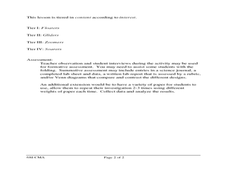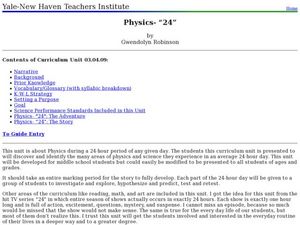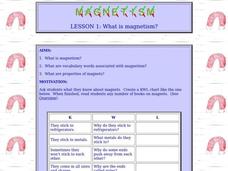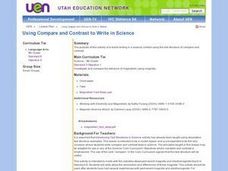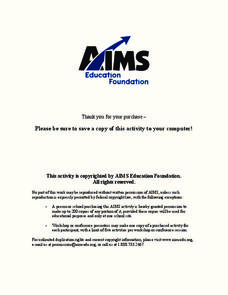Curated OER
What Do Magnets Do?
Second graders discover the physical properties of magnets. In this physics lesson, 2nd graders investigate the differences between natural and man made magnets and the uses of each. Students complete 4 separate RAFT...
Curated OER
PHYSICS LESSONS
Students study the concept of electricity, what an electric current is and its relationship between voltage and resistance.In this electrical lesson students solve problems using Ohm's law, and research alternative sources of electricity.
Curated OER
Properties of Matter (Biomaterial Through Nanotechnology)
Students investigate friction between different surfaces. In this physics lesson, students research biomaterials that can reduce friction. They calculate efficiency using a mathematical formula.
Curated OER
Origami Flight: The Physical Setting
Sixth graders investigate the forces that move certain objects. In this physics lesson, 6th graders design and create paper flying objects using origami methods, which they practice flying in different conditions. Students...
Curated OER
Physics "24"
Students construct a model house or school. In this physics lesson, students research about who wind up clocks work and write an essay about it. They determine the center of gravity of different objects.
Curated OER
The Phantom of the Computer Lab
Young scholars calculate the power consumption of computers in school. In this physics lesson, students design an experiment to determine whether the school should unplug computers at the end of the day. They collect data and report...
Curated OER
Energy and Work: Transformation Through Engines
Students conduct a webquest on an energy source they chose. In this physics lesson, students design an experiment to determine the factors affecting potential and kinetic energy. They calculate speed and create distance vs. time graphs.
Curated OER
Gravity Gets You Down
Students design an experiment to investigate how objects with different masses fall. In this physics lesson, students predict how these objects will fall in a vacuum tube. They write a report explaining experimental results and conclusion.
Curated OER
Magnetic Field
Students explore how compass and Gauss meter detect a magnetic field. In this physics instructional activity, students build their own Gauss meter and sensor based on given procedure. They cite real world applications of magnetism.
Curated OER
Balloons: Math with the Montgolfier Balloon
Young scholars discover the history of hot air balloons by watching one ascent. In this physics lesson, students utilize a Montgolfier Hot Air Balloon from an earlier lesson and record the temperature, rate of ascent and the...
Curated OER
Woodwind Instruments and Pitch
Young scholars explore musical pitch. In this cross curriculum musical instruments and "sound" physics lesson, students identify and describe common traits of woodwind instruments. Young scholars research "pitch" and what causes pitch...
Curated OER
Principles of Flight: Bernoulli's Lift
Students discover how air pressure effects flight. In this physics activity, students create two types of airplane wings so they can observe the way air pressure creates lift. Students utilize a printout to create the...
Curated OER
So Fast! So Slow!
Fifth graders give examples of objects that move slow and fast. In this physics instructional activity, 5th graders rank animals according to how quickly they move. They create a bar graph of organisms versus rates of speed.
Curated OER
Machines All Around Us
Learners identify simple machines. In this physics lesson, students explore different rooms in the school building, looking for simple machines. Learners use a digital camera to take pictures of the simple machines.
Curated OER
Internet Field Trip: Simple Machines
Students research simple machines. In this physics lesson plan, students participate in a WebQuest to gain knowledge about simple machines. WebQuest activities and worksheets are included in this lesson plan.
Curated OER
What is Magnetism?
Students investigate magnetism. In this physics instructional activity, students create a KWL chart about magnetism and research various suggested websites to find out more about magnetism. Students log on to the "BrainPOP" website and...
Curated OER
Power Blackout Assessment
Students discuss the importance of power grids in power generation. In this physics instructional activity, students explain the impact of power failure. They investigate the power blackout in 2003 and discuss their findings.
Curated OER
Energy Efficiency: It really IS important!
Students compare the energy needed to produce new products versus recycling. In this physics lesson, students brainstorm ways to save energy. They create a presentation about the correlation between conserving energy and energy costs.
Curated OER
Newton's First Law Crash!
Students define what inertia is in their own words. In this physics lesson plan, students observe what happens to their action figure as the skateboard stops suddenly. They apply Newton's 1st law to real world situations.
Alabama Learning Exchange
This Is How We Roll!
Students research how roller coasters work. In this physics instructional activity, learners research the history of roller coasters and the safety factors in the design of a roller coaster on the website...
Curated OER
Is That Icebox Green?
Seventh graders create a timeline of the development of electrical appliances. In this physics lesson, 7th graders explore energy consumption over the past 90 years. They create a poster about their chosen electrical device detailing its...
Curated OER
Laser
Eleventh graders explore the different steps in the engineering process. In this physics instructional activity, 11th graders design an experiment based on topic given. They prepare a presentation and share it with the class.
Curated OER
Using Compare and Contrast to Write in Science
Fifth graders investigate and compare the behavior of magnetism using magnets. In this physics instructional activity, 5th graders write about the similarities and differences of a variety of magnet types.
Curated OER
Blow and Go
Students discover how air can move things by using their breath. In this physics lesson, students hypothesize then attempt to move a pencil 1 meter using nothing but their breath. Students record data from their experiment including...
Other popular searches
- High School Lessons Physics
- Elementary Physics Lessons
- Physics Lessons Forces
- Tiered Lessons in Physics



